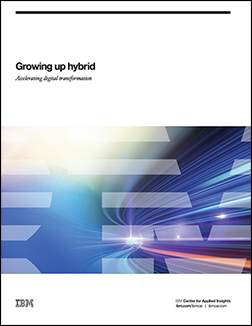For many IT organizations, interest in hybrid cloud is the highest it has ever been. However, it can often be difficult for these organizations to separate hype from reality. In spite of all the talk, questions still abound: what does a great hybrid cloud environment actually look like? What are the main differences between leading hybrid organizations and others that are less successful? Perhaps most importantly, what kind of benefits do these organizations actually enjoy as a result of their move to hybrid?
Fortunately, the IBM Center for Applied Insights has published a documentfilled with answers. The report, titled Growing Up Hybrid, is based on a survey the center conducted of 500 hybrid cloud decision makers from across the globe. The results of the survey were used to draw key insights for the report, which we will summarize in this post.
Key Finding #1: There’s more than one reason to pursue hybrid cloud
The ability to improve IT productivity by offloading resources and management complexity to the cloud is often named as one of the foremost reasons organizations choose to pursue hybrid cloud. While the IBM survey found that participants did indeed name this as their most important goal for adopting hybrid cloud, it’s also significant that it wasn’t the only goal.
A close second to increasing productivity was the ability to increase security and mitigate risk, while cutting costs and scaling to handle dynamic workloads were also important to a significant number of organizations. The lesson here is that there’s more than one way to benefit from hybrid cloud, so organizations that focus on only one benefit will be selling themselves short.
Key Finding #2: Leading organizations recognize that nothing can match hybrid
In order to understand how different organizations approach hybrid cloud differently, the report divided up survey respondents based on their hybrid cloud management maturity, as well as their ability to drive competitive advantage through hybrid cloud. Those organizations that ranked themselves highly in both of these regards were considered Frontrunners; those with the lowest levels of success were considered Chasers, while those in between the two extremes were considered Challengers.
Perhaps one of the greatest insights about hybrid cloud Frontrunners is the fact that the vast majority of them told surveyors they would not have been able to achieve the same level of success with any other kind of IT environment. Nine out of 10 Frontrunners said that their hybrid cloud environment provided a greater return on investment than either an all-traditional or all-cloud IT environment could.
Key Finding #3: Hybrid cloud leaders make the most of both old and new
For many IT leaders, moving to hybrid cloud can seem like a scary proposition, due primarily to the fact that they assume costly infrastructure investments will be needed just to enjoy many of the benefits hybrid offers.
The survey results show that this was not the case among hybrid cloud Frontrunners. While these organizations experienced better results than other organizations across the board, the one area where they really shined was in their ability to maximize the value of their existing traditional infrastructure. Frontrunners were nearly twice as likely to do this as Chasers. This shows that far from requiring you to throw out the old and start over from scratch, hybrid cloud is among the best ways to breathe new life into the systems you already own.
Key Finding #4: Leaders use hybrid cloud to grow and get better
With all the positive results Frontrunners are achieving with hybrid cloud, it would be easy to understand if they were to simply sit back and enjoy what they’ve already achieved. Instead, the opposite has proved true: leading organizations are using hybrid cloud to promote change, growth and innovation.
According to the survey results, Frontrunners were twice as likely to use hybrid cloud to support product and service innovation as Chasers were, and also four times as likely to launch new digital services using hybrid cloud. Clearly, hybrid cloud adoption can drive benefits both now and into the future.
Learn more
 To find out more about the insights included in the report, download and read the full report today.
To find out more about the insights included in the report, download and read the full report today.
Also, if you're interested in learning what the optimum hybrid cloud environment for your business might look like, contact Cima to schedule your free RightCloud hybrid cloud assessment workshop.
Schedule your RightCloud workshop today
Thanks for reading.
Jim
James Cunningham serves as the Chief Technology Officer at Cima Solutions Group. His experience in Healthcare operations and infrastructure support has enabled him to effectively move workloads into various cloud computing models. With 19 years in the IT field he carries several industry standard certifications, specializing in x86 and virtualization. Prior to Cima, James spent 15 years in Healthcare IT. He was Manager of Infrastructure at Parkland Hospital in Dallas. He has also spent over 10 years at The MetroHealth System in Cleveland, in Systems Engineering and EMR System Support.



Leave a comment!